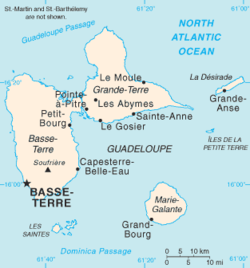Invasion of Guadeloupe (1815)
| Invasion of Guadeloupe | |||||||
|---|---|---|---|---|---|---|---|
| Part of The Hundred Days | |||||||
 Map of Guadeloupe. |
|||||||
|
|||||||
| Belligerents | |||||||
|
|
|
||||||
| Commanders and leaders | |||||||
| Admiral Comte de Linois | Lieutenant-General Sir James Leith | ||||||
| Strength | |||||||
| c.6,000 troops and National Guards |
|
||||||
| Casualties and losses | |||||||
| 16 killed 51 wounded 4 missing |
|||||||
The Invasion of Guadeloupe (8–10 August 1815) was the last conflict between French and British forces during the Napoleonic Wars, and took place after Napoleon's defeat at Waterloo.
Guadeloupe had been captured by the British twice before, most recently in 1810, but had been returned to the French following Napoleon's first abdication in April 1814. Louis XVIII had appointed Admiral Charles-Alexandre Léon Durand Linois as Governor, with General as his deputy.
News of Napoleon's return from exile in Elba in February 1815 eventually reached the island in May, and divided the island. Linois remained loyal to the King, while Boyer-Peyreleau led the Bonapartists. On 15 June the schooner Argile arrived from France with orders to rally Guadeloupe and Martinique to Bonaparte's cause.
Boyer-Peyreleau attempted to persuade Linois to declare his support for Bonaparte, but he refused, so on 18 June Boyer-Peyreleau began arresting key officials and held Linois under house arrest. The next day Linois reluctantly declared his support for the new regime. Unfortunately, unknown to them, Bonaparte had been defeated at Waterloo on 18 June, and would abdicate soon after.
Meanwhile, on Martinique, the Governor , had requested British assistance in holding the island on behalf of the French King, with British troops landing there in June.
On learning of the situation in Guadeloupe, the commander of British forces in the West Indies, Lieutenant-General Sir James Leith, a veteran of the Peninsular War, promptly assembled an expeditionary force, with naval support under the command of Rear-Admiral Sir Philip Durham.
Leith's forces comprised about 5,000 troops and an artillery corps, carried on over fifty troop ships and transports, supported by the British naval ships Dasher, Fairy, Espiegle and Columbia, all 18-gun brig-sloops; the sloops Muros (22 guns) and Barbadoes (16 guns), both former American privateers; and Chanticleer, a 10 gun brig. De Vaugiraud provided the corvettes Acteon and Diligent, and the schooner Le Messager, with a contingent of French troops from Martinique. The British troops were organised into three brigades, commanded by Major-Generals Sir Charles Shipley, Stehelin and Douglass. They consisted of the 1st Battalions of the 15th, 25th, 63rd Regiments of Foot; the Royal West India Rangers, the York Chasseurs and the Royal York Rangers, (all penal battalions); and detachments of the West India Regiment.
...
Wikipedia
